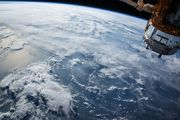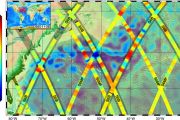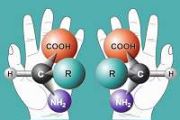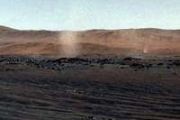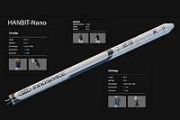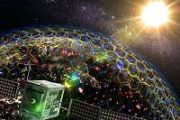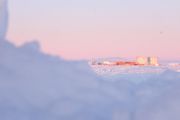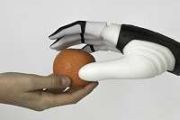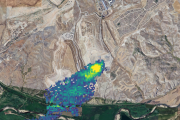
Copernical Team
ECOSTRESS data incorporated into new wildfire response tool
 NASA's ECOsystem Spaceborne Thermal Radiometer Experiment on Space Station (ECOSTRESS) is aiding in the fight against fires in the Western U.S.
As of July 28, 2021, the size of the Bootleg Fire in southern Oregon was more than 410,000 acres, making it the largest wildfire currently burning in the U.S. So far, some 400 buildings and more than 340 vehicles have been destroyed. Wildfire respo
NASA's ECOsystem Spaceborne Thermal Radiometer Experiment on Space Station (ECOSTRESS) is aiding in the fight against fires in the Western U.S.
As of July 28, 2021, the size of the Bootleg Fire in southern Oregon was more than 410,000 acres, making it the largest wildfire currently burning in the U.S. So far, some 400 buildings and more than 340 vehicles have been destroyed. Wildfire respo Ball Aerospace completes preliminary design review of NOAA's Space Weather Satellite
 Ball Aerospace successfully completed the preliminary design review (PDR) for the National Oceanic and Atmospheric Administration's (NOAA's) Space Weather Follow On-Lagrange 1 (SWFO-L1) spacecraft. With PDR complete, the spacecraft now moves into the critical design phase.
Ball was awarded the contract to design and build the SWFO-L1 spacecraft on June 25, 2020 by NASA's Goddard Space Flig
Ball Aerospace successfully completed the preliminary design review (PDR) for the National Oceanic and Atmospheric Administration's (NOAA's) Space Weather Follow On-Lagrange 1 (SWFO-L1) spacecraft. With PDR complete, the spacecraft now moves into the critical design phase.
Ball was awarded the contract to design and build the SWFO-L1 spacecraft on June 25, 2020 by NASA's Goddard Space Flig Geologists take Earth's inner temperature using erupted sea glass
 If the Earth's oceans were drained completely, they would reveal a massive chain of undersea volcanoes snaking around the planet. This sprawling ocean ridge system is a product of overturning material in the Earth's interior, where boiling temperatures can melt and loft rocks up through the crust, splitting the sea floor and reshaping the planet's surface over hundreds of millions of years.
If the Earth's oceans were drained completely, they would reveal a massive chain of undersea volcanoes snaking around the planet. This sprawling ocean ridge system is a product of overturning material in the Earth's interior, where boiling temperatures can melt and loft rocks up through the crust, splitting the sea floor and reshaping the planet's surface over hundreds of millions of years. Reprogrammable satellite launched

A sophisticated telecommunications satellite that can be completely repurposed while in space has launched.
High-stakes Boeing capsule launch postponed due to mishap at ISS
 Boeing and NASA postponed the launch the company's Starliner space capsule to the International Space Station on Friday after a mishap at the orbital laboratory on Thursday.
A United Launch Alliance Atlas V rocket had been scheduled to launch the capsule on an uncrewed test flight from Florida. But a new Russian module, Nauka, created a brief crisis at the space station when the module'
Boeing and NASA postponed the launch the company's Starliner space capsule to the International Space Station on Friday after a mishap at the orbital laboratory on Thursday.
A United Launch Alliance Atlas V rocket had been scheduled to launch the capsule on an uncrewed test flight from Florida. But a new Russian module, Nauka, created a brief crisis at the space station when the module' US watchdog upholds SpaceX's Moon lander contract
 NASA did not violate regulations when it decided to give SpaceX the sole contract to build a Moon lander, a watchdog said Friday, in a ruling that denied challenges by competitors Blue Origin and Dynetics.
The human landing system (HLS) contract, worth $2.9 billion, was given to Elon Musk's company in April, but was protested by the other bidders, who argued NASA was required to make multipl
NASA did not violate regulations when it decided to give SpaceX the sole contract to build a Moon lander, a watchdog said Friday, in a ruling that denied challenges by competitors Blue Origin and Dynetics.
The human landing system (HLS) contract, worth $2.9 billion, was given to Elon Musk's company in April, but was protested by the other bidders, who argued NASA was required to make multipl Government watchdog denies protests of SpaceX's lunar lander contract
 A U.S. government watchdog denied protests Friday of NASA's nearly $3 billion contract award to Elon Musk's SpaceX to build a lunar lander for astronaut missions.
In denying the arguments made by Jeff Bezos' Blue Origin and Alabama-based Dynetics, the Government Accountability Office noted that NASA's options for the contract were restricted by a lack of congressional funding.
NA
A U.S. government watchdog denied protests Friday of NASA's nearly $3 billion contract award to Elon Musk's SpaceX to build a lunar lander for astronaut missions.
In denying the arguments made by Jeff Bezos' Blue Origin and Alabama-based Dynetics, the Government Accountability Office noted that NASA's options for the contract were restricted by a lack of congressional funding.
NA World's first commercial re-programmable satellite blasts into space
 The world's first commercial fully re-programmable satellite lifted off from French Guiana on Friday on board an Ariane 5 rocket, ushering in a new era of more flexible communications.
Unlike conventional models that are designed and "hard-wired" on Earth and cannot be repurposed once in orbit, the Eutelsat Quantum allows users to tailor the communications to their needs - almost in real-ti
The world's first commercial fully re-programmable satellite lifted off from French Guiana on Friday on board an Ariane 5 rocket, ushering in a new era of more flexible communications.
Unlike conventional models that are designed and "hard-wired" on Earth and cannot be repurposed once in orbit, the Eutelsat Quantum allows users to tailor the communications to their needs - almost in real-ti Eutelsat Quantum liftoff
 Video:
00:00:49
Video:
00:00:49
The first flight of Ariane 5 in 2021 delivers two satellites including the ESA-backed telecommunications satellite Eutelsat Quantum into space.
Ariane 5 launches pioneering reprogrammable telecommunications satellite
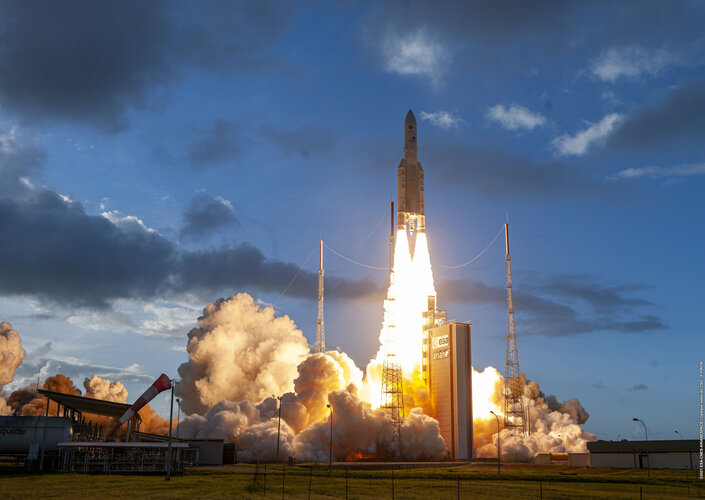
Europe’s Ariane 5 has delivered two telecom satellites Star One D2 and Eutelsat Quantum into their planned transfer orbits.




